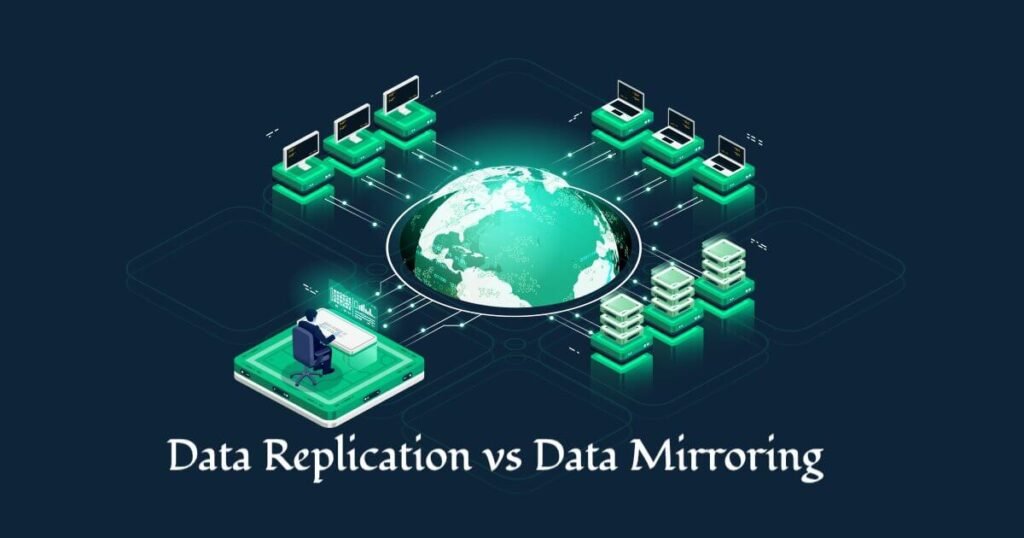Data Replication vs Data Mirroring
In this tutorial, we are going to discuss about Data Replication vs Data Mirroring. Data replication and data mirroring are both techniques used to ensure data availability, fault tolerance, and disaster recovery in distributed systems, but they serve slightly different purposes and have distinct implementations.
Data replication and data mirroring are both methods used in managing and safeguarding data, particularly in the context of databases and storage systems. While they share similarities in creating copies of data, they serve different purposes and have distinct operational characteristics.

Data Replication
- Data Replication involves copying data from one location to another. The replication can be synchronous or asynchronous.
- Data replication involves creating and maintaining multiple copies of data across different storage locations or nodes within a distributed system. These copies are typically synchronized periodically to ensure consistency and availability.
Characteristics
- Asynchronous/Synchronous: Data replication can be done in real-time (synchronous) or with some delay (asynchronous).
- Multiple Copies: Often creates multiple copies of data, which can be stored across different servers or locations.
- Purpose: Enhances data availability and accessibility, used for load balancing, and enables data analysis without impacting the primary data source.
- Use Cases: In distributed databases, backup systems, and data warehouses.
Example
- A company might replicate its database across multiple data centers to ensure that if one data center goes down, the others can still serve the data.
Pros:
- Improved Fault Tolerance: Replicating data across multiple nodes provides redundancy, ensuring that data remains accessible even if one or more nodes fail.
- High Availability: With data replicated across multiple nodes, applications can access data from the nearest or most available node, reducing latency and ensuring continuous access to data.
- Load Balancing: Replication can help distribute read and write loads across multiple nodes, improving system performance and scalability.
- Disaster Recovery: In the event of a catastrophic failure or data loss, replicated data can be used for disaster recovery purposes, minimizing downtime and data loss.
Cons:
- Complexity: Implementing and managing data replication can be complex, requiring synchronization mechanisms, conflict resolution strategies, and careful coordination to maintain data consistency across replicas.
- Increased Storage Overhead: Maintaining multiple copies of data incurs storage overhead, consuming additional storage capacity and resources.
- Data Consistency Challenges: Synchronizing data across replicas introduces challenges related to ensuring data consistency, handling conflicts, and managing updates.
Data Mirroring
- Data Mirroring refers to the process of creating an exact replica of a database or storage system, usually in real-time.
- Data mirroring is a specific form of data replication where data is duplicated in real-time or near-real-time across multiple storage devices or systems. Mirroring typically involves maintaining an exact replica of data on a secondary storage device or system.
Characteristics
- Synchronous: Mirroring is typically synchronous, meaning the data in the primary and mirror locations are always in sync.
- Redundancy for High Availability: Primarily used for redundancy and high availability.
- Mirror Copy: Usually involves a one-to-one relationship between the original and the mirror. If data changes in the original location, it is immediately written to the mirror.
- Use Cases: In critical applications requiring high availability and data integrity, such as financial transaction systems.
Example
- A financial services firm may use data mirroring to ensure that all transactional data is instantly copied to a secondary server, which can take over with no data loss in case the primary server fails.
Pros
- Real-Time Data Redundancy: Data mirroring ensures that changes made to the primary data are immediately replicated to the mirrored copy, providing real-time redundancy and fault tolerance.
- Fast Failover: In the event of a primary storage failure, mirroring allows for quick failover to the mirrored copy, minimizing downtime and ensuring continuous data access.
- Simplified Recovery: Mirrored data can be easily used for disaster recovery purposes, simplifying the recovery process and minimizing data loss.
Cons
- Synchronization Overhead: Maintaining real-time synchronization between primary and mirrored data incurs overhead, potentially impacting system performance and scalability.
- Cost: Data mirroring requires additional storage capacity and resources to maintain mirrored copies, increasing infrastructure costs.
- Single Point of Failure: While data mirroring provides redundancy, both primary and mirrored copies are susceptible to simultaneous failures if they share common points of failure, such as power supplies or network connections.
Key Differences
- Real-Time Synchronization:
- Replication: Can be either synchronous or asynchronous.
- Mirroring: Typically synchronous.
- Purpose and Use:
- Replication: Used for load balancing, data localization, and reporting.
- Mirroring: Primarily for disaster recovery and high availability.
- Number of Copies:
- Replication: Can create multiple copies of data in different locations.
- Mirroring: Usually involves a single mirror copy.
- Performance Impact:
- Replication: Can be designed to minimize performance impact.
- Mirroring: Since it’s synchronous, it might have a more significant impact on performance.
- Flexibility:
- Replication: More flexible in terms of configuration and use cases.
- Mirroring: More rigid, focused on creating a real-time exact copy for redundancy.
Choosing between data replication and data mirroring depends on the specific requirements of the system in terms of availability, performance, and the nature of the data being managed. In many systems, both techniques are used in conjunction to achieve both scalability and high availability.
In summary, both data replication and data mirroring are essential techniques for ensuring data availability, fault tolerance, and disaster recovery in distributed systems. Data replication offers flexibility and scalability but requires careful management to maintain data consistency, while data mirroring provides real-time redundancy with minimal failover time but may incur higher overhead and cost. The choice between data replication and data mirroring depends on factors such as performance requirements, data consistency needs, and budget constraints.
That’s all about the Data Replication vs Data Mirroring. If you have any queries or feedback, please write us email at contact@waytoeasylearn.com. Enjoy learning, Enjoy system design..!!